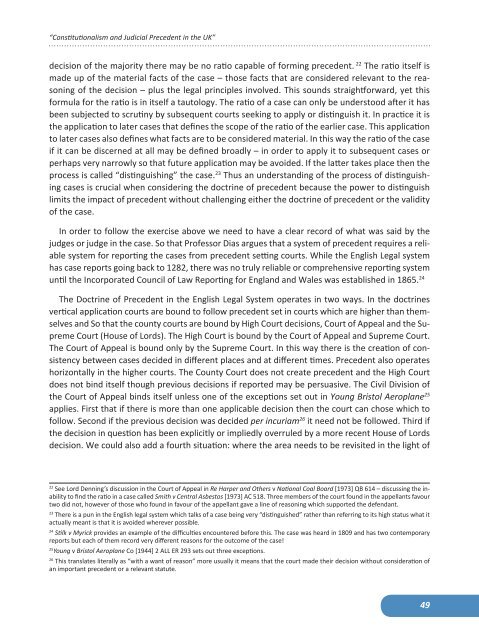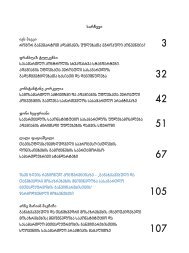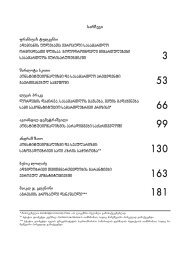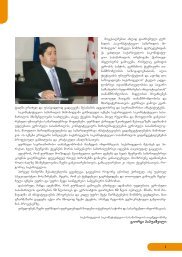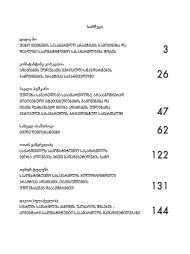Contents - Constitutional Court of Georgia
Contents - Constitutional Court of Georgia
Contents - Constitutional Court of Georgia
Create successful ePaper yourself
Turn your PDF publications into a flip-book with our unique Google optimized e-Paper software.
“<strong>Constitutional</strong>ism and Judicial Precedent in the UK”<br />
decision <strong>of</strong> the majority there may be no ratio capable <strong>of</strong> forming precedent. 22 The ratio itself is<br />
made up <strong>of</strong> the material facts <strong>of</strong> the case – those facts that are considered relevant to the reasoning<br />
<strong>of</strong> the decision – plus the legal principles involved. This sounds straightforward, yet this<br />
formula for the ratio is in itself a tautology. The ratio <strong>of</strong> a case can only be understood after it has<br />
been subjected to scrutiny by subsequent courts seeking to apply or distinguish it. In practice it is<br />
the application to later cases that defines the scope <strong>of</strong> the ratio <strong>of</strong> the earlier case. This application<br />
to later cases also defines what facts are to be considered material. In this way the ratio <strong>of</strong> the case<br />
if it can be discerned at all may be defined broadly – in order to apply it to subsequent cases or<br />
perhaps very narrowly so that future application may be avoided. If the latter takes place then the<br />
process is called “distinguishing” the case. 23 Thus an understanding <strong>of</strong> the process <strong>of</strong> distinguishing<br />
cases is crucial when considering the doctrine <strong>of</strong> precedent because the power to distinguish<br />
limits the impact <strong>of</strong> precedent without challenging either the doctrine <strong>of</strong> precedent or the validity<br />
<strong>of</strong> the case.<br />
In order to follow the exercise above we need to have a clear record <strong>of</strong> what was said by the<br />
judges or judge in the case. So that Pr<strong>of</strong>essor Dias argues that a system <strong>of</strong> precedent requires a reliable<br />
system for reporting the cases from precedent setting courts. While the English Legal system<br />
has case reports going back to 1282, there was no truly reliable or comprehensive reporting system<br />
until the Incorporated Council <strong>of</strong> Law Reporting for England and Wales was established in 1865. 24<br />
The Doctrine <strong>of</strong> Precedent in the English Legal System operates in two ways. In the doctrines<br />
vertical application courts are bound to follow precedent set in courts which are higher than themselves<br />
and So that the county courts are bound by High <strong>Court</strong> decisions, <strong>Court</strong> <strong>of</strong> Appeal and the Supreme<br />
<strong>Court</strong> (House <strong>of</strong> Lords). The High <strong>Court</strong> is bound by the <strong>Court</strong> <strong>of</strong> Appeal and Supreme <strong>Court</strong>.<br />
The <strong>Court</strong> <strong>of</strong> Appeal is bound only by the Supreme <strong>Court</strong>. In this way there is the creation <strong>of</strong> consistency<br />
between cases decided in different places and at different times. Precedent also operates<br />
horizontally in the higher courts. The County <strong>Court</strong> does not create precedent and the High <strong>Court</strong><br />
does not bind itself though previous decisions if reported may be persuasive. The Civil Division <strong>of</strong><br />
the <strong>Court</strong> <strong>of</strong> Appeal binds itself unless one <strong>of</strong> the exceptions set out in Young Bristol Aeroplane 25<br />
applies. First that if there is more than one applicable decision then the court can chose which to<br />
follow. Second if the previous decision was decided per incuriam 26 it need not be followed. Third if<br />
the decision in question has been explicitly or impliedly overruled by a more recent House <strong>of</strong> Lords<br />
decision. We could also add a fourth situation: where the area needs to be revisited in the light <strong>of</strong><br />
22 See Lord Denning’s discussion in the <strong>Court</strong> <strong>of</strong> Appeal in Re Harper and Others v National Coal Board [1973] QB 614 – discussing the inability<br />
to find the ratio in a case called Smith v Central Asbestos [1973] AC 518. Three members <strong>of</strong> the court found in the appellants favour<br />
two did not, however <strong>of</strong> those who found in favour <strong>of</strong> the appellant gave a line <strong>of</strong> reasoning which supported the defendant.<br />
23 There is a pun in the English legal system which talks <strong>of</strong> a case being very “distinguished” rather than referring to its high status what it<br />
actually meant is that it is avoided wherever possible.<br />
24 Stilk v Myrick provides an example <strong>of</strong> the difficulties encountered before this. The case was heard in 1809 and has two contemporary<br />
reports but each <strong>of</strong> them record very different reasons for the outcome <strong>of</strong> the case!<br />
25 Young v Bristol Aeroplane Co [1944] 2 ALL ER 293 sets out three exceptions.<br />
26 This translates literally as “with a want <strong>of</strong> reason” more usually it means that the court made their decision without consideration <strong>of</strong><br />
an important precedent or a relevant statute.<br />
49


